Study on the Driver Visual Workload of Bridge-Tunnel Groups on Mountainous Expressways
Abstract
:1. Introduction
2. Materials and Methods
2.1. Experimental Scenario
| Name | Definition |
|---|---|
| Freeway tunnel group | A freeway tunnel group refers to a collection of tunnels where the distance between adjacent tunnel portals is less than 100 m [39]. It is a collective term for adjacent or continuous tunnels [40]. The vehicles entering the downstream tunnel will affect those traveling between downstream and upstream tunnels [41]. |
| Adjacent tunnels | Adjacent tunnels comprise two tunnels with a distance between their portals of less than 250 m [36]. When the design speed is 80 km/h, the maximum spacing should be controlled within 110 m [42]. If the length of the connecting section between the tunnel groups is less than the stopping sight distance, drivers exiting the upstream tunnel may fail to brake promptly when they observe obstacles at the entrance of the downstream tunnel. The vehicles entering the downstream tunnel may affect those traveling inside the upstream tunnel [41]. |
| Continuous tunnels | Continuous tunnels are two tunnels with a distance between them, ranging from 250 to 1000 m [12,36]. At the design speed of 80 km/h, the distance between continuous tunnels should not exceed 377 m [42]. This distance ensures that drivers exiting the upstream tunnel can brake promptly when seeing obstacles at the entrance of the downstream tunnel during light adaptation [41]. |
| Freeway bridge group | A bridge group is a road section with two or more bridges spaced within 1 km, among which at least one bridge has a length of 500 m or more. It describes a group of bridges spaced at a certain distance, typically on expressways [37,43]. |
| Bridge-tunnel group | A bridge-tunnel group is a section of road where the distance between the bridges and tunnels, tunnels, or bridges is less than or equal to the travel distance in 5 s at the designed vehicle speed [43]. |
2.2. Participants
2.3. Test Vehicle and Facilities
2.4. Experimental Procedure
3. Results
3.1. Drivers’ Fixation Area
3.2. Pupil Diameter of the Drivers
3.3. The Influence of Tunnel Length on Pupil Diameter
3.4. The Impact of Adjacent Tunnel Spacing on Pupil Diameter
3.5. The Effect of Natural Light Conditions on Pupil Diameter
3.6. Evaluation of Driver Visual Load
4. Discussion
5. Conclusions
- (1)
- In order to ensure driving safety in mountain highway bridge-tunnel groups, the participants of the experiments are all experienced drivers. The sample size is small, and the distribution is uneven. This study did not consider the influence of driver type on visual characteristics, and subsequent studies can further analyze the visual characteristics of drivers in terms of their gender, age, nationality, road familiarity, and driving style.
- (2)
- This study only uses two indicators, namely, fixation area and pupil diameter, to study driving behaviors in bridge-tunnel groups. Relevant studies on gaze time, gaze area division, and gaze transfer characteristics can be carried out in the future. Moreover, EEG, ECG, and myoelectric data can be obtained by physiological instruments to carry out a comprehensive analysis of the driver’s driving load.
- (3)
- This study is mainly carried out from an overall perspective of bridge-tunnel groups and does not fully consider the impact of bridge and tunnel geometric alignment on drivers’ visual characteristics, which will be further investigated in the future.
Author Contributions
Funding
Institutional Review Board Statement
Informed Consent Statement
Data Availability Statement
Acknowledgments
Conflicts of Interest
References
- JTG B01-2014; Technical Standards for Highway Engineering. Ministry of Transport of the People’s Republic of China: Beijing, China, 2014.
- Statistics Bulletin about the Development of Transportation Industry of China; Ministry of Transport of the People’s Republic of China: Beijing, China, 2021.
- Sun, Z.; Liu, S.; Tang, J.; Wu, P.; Tang, B. Exploring the Impacts of Driving Environment on Crashes in Tunnel–Bridge–Tunnel Groups: An Eight-Zone Analytic Approach. Sustainability 2021, 13, 2272. [Google Scholar] [CrossRef]
- Bassan, S. Overview of traffic safety aspects and design in road tunnels. IATSS Res. 2016, 40, 35–46. [Google Scholar] [CrossRef]
- Amundsen, F.; Ranes, G. Studies on traffic accidents in Norwegian road tunnels. Tunn. Undergr. Space Technol. 2000, 15, 3–11. [Google Scholar] [CrossRef]
- Caliendo, C.; De Guglielmo, M.L. Accident Rates in Road Tunnels and Social Cost Evaluation. Procedia-Soc. Behav. Sci. 2012, 53, 166–177. [Google Scholar] [CrossRef]
- Sun, Z.; Liu, S.; Li, D.; Tang, B.; Fang, S. Crash analysis of mountainous freeways with high bridge and tunnel ratios using road scenario-based discretization. PLoS ONE 2020, 15, e0237408. [Google Scholar] [CrossRef] [PubMed]
- Wang, J.; Pervez, A.; Wang, Z.; Han, C.; Hu, L.; Huang, H. Crash analysis of Chinese freeway tunnel groups using a five-zone analytic approach. Tunn. Undergr. Space Technol. 2018, 82, 358–365. [Google Scholar] [CrossRef]
- Bai, J.; Lin, Q.; Bi, H.; Tang, B. Drivers’ Eye Movement Characteristics in a Combined Bridge-Tunnel Scenario on a Mountainous Urban Expressway: A Realistic Study. J. Adv. Transp. 2022, 2022, 6403277. [Google Scholar] [CrossRef]
- Lee, J.; Kirytopoulos, K.; Pervez, A.; Huang, H. Understanding drivers’ awareness, habits and intentions inside road tunnels for effective safety policies. Accid. Anal. Prev. 2022, 172, 106690. [Google Scholar] [CrossRef]
- JTG D20-2017; Design Specification for Highway Alignment. Ministry of Transport of the People’s Republic of China: Beijing, China, 2017.
- JTG 3370.1-2018; Specifications for Design of Highway Tunnel. Ministry of Transport of the People’s Republic of China: Beijing, China, 2018.
- JTG/T D21-2014; Guidelines for Design of Highway Grade-Separated Intersections. Ministry of Transport of the People’s Republic of China: Beijing, China, 2014.
- Hu, S.F. Traffic Accident Characteristics and Mechanism Analysis of Mountain Highway Tunnel Group. Highway 2016, 61, 134–138. [Google Scholar]
- Wen, H.; Sun, J.; Zeng, Q.; Zhang, X.; Yuan, Q. The Effects of Traffic Composition on Freeway Crash Frequency by Injury Severity: A Bayesian Multivariate Spatial Modeling Approach. J. Adv. Transp. 2018, 2018, 6964828. [Google Scholar] [CrossRef]
- Shang, T.; Qi, H.; Huang, A.; Liu, T. A comparative driving safety study of mountainous expressway individual tunnel and tunnel group based on eye gaze behavior. PLoS ONE 2022, 17, e0263835. [Google Scholar] [CrossRef]
- Bao, X.W. Traffic Safety Analysis of Bridge and Tunnel Clusters on Mountain Highways. Transp. World 2020, 35, 103–108. [Google Scholar]
- Wang, W.Z.; Shi, X.F.; Zhang, H.B.; He, J.P. Study on the Characteristics Analysis of Traffic Accidents on the Hangzhou Bay Bridge. Highway 2016, 61, 152–156. [Google Scholar]
- Zhao, X.H.; Yang, H.Y.; Yao, Y.; Guo, M.; Qi, H.; Dai, Y.B.; Su, Y.L. Traffic Safety Evaluation and Feature Analysis of Freeway Bridge Sections. J. TongJi Univ. (Nat. Sci.) 2022, 50, 1637–1646. [Google Scholar] [CrossRef]
- Mo, F. Discussion on the Design of Gradient Zone Expressway in the Sichuan-Tibet Plateau. Highw. Traffic Sci. Technol. (Appl. Technol. Ed.) 2019, 7, 49–52. [Google Scholar]
- Shaohui, C.; Mao, L.; Nale, Z. A Study on Traffic Risk Assessment of Road Section with High Rate of Bridge and Tunnel of Freeway. In Proceedings of the 8th International Conference on Intelligent Computation Technology and Automation (ICICTA), Nanchang, China, 14–15 June 2016. [Google Scholar] [CrossRef]
- Qiao, J.; Wang, J.; Xie, Y.D.; Chen, Y.X. Study on safety distance of bridge-tunnel transition sections considering drivers’ psychological and physiological parameters. J. Chongqing Univ. Technol. (Nat. Sci.) 2023, 37, 274–281. [Google Scholar] [CrossRef]
- Jing-rong, B.A.; Bo-ming, T.A.; Zong-yuan, S.U.; Hui-yun, B.I.; Tian-jun, X.I. On Driving Load of Super-long Tunnel Adjacent to Interchanges. J. Transp. Syst. Eng. Inf. Technol. 2022, 22, 301–310. [Google Scholar] [CrossRef]
- Moreno, A.T.; Garcia, A.; Camacho-Torregrosa, F.J.; Llorca, C. Influence of highway three-dimensional coordination on drivers’ perception of horizontal curvature and available sight distance. IET Intell. Transp. Syst. 2013, 7, 244–250. [Google Scholar] [CrossRef]
- Biernacki, M.P.; Lewkowicz, R. How do older drivers perceive visual information under increasing cognitive load? Significance of personality on-road safety. Accid. Anal. Prev. 2021, 157, 106186. [Google Scholar] [CrossRef]
- Underwood, G. Visual attention and the transition from novice to advanced driver. Ergonomics 2007, 50, 1235–1249. [Google Scholar] [CrossRef]
- Rayner, K. Eye movements in reading and information processing. Psychol. Bull. USA 1978, 85, 618–660. [Google Scholar] [CrossRef]
- Meng-meng, D.U.; Bo-ming, T.; Xu-hui, H.U.; Bai-ke, H.E.; Tang-zhi, L.I. Driver’s Visual Load at Tunnel Entrance and Exit of Sections with High Ratio of Tunnels. J. Transp. Syst. Eng. Inf. Technol. 2018, 18, 113–119. [Google Scholar] [CrossRef]
- Wang, S.; Du, Z.; Jiao, F.; Zheng, H.; Ni, Y. Drivers’ visual load at different time periods in entrance and exit zones of extra-long tunnel. Traffic Inj. Prev. 2020, 21, 539–544. [Google Scholar] [CrossRef] [PubMed]
- Xu, J.; Zhang, X.; Liu, H.; Yang, K.; Ma, F.; Li, H.; Sun, Y. Physiological indices and driving performance of drivers at tunnel entrances and exits: A simulated driving study. PLoS ONE 2020, 15, e0243931. [Google Scholar] [CrossRef]
- Du, Z.; Wan, H.; Wu, C.; Pan, X. Safety Evaluation of Highway Tunnel-Entrance Illuminance Transition Based on Eye-Pupil Changes. Promet-Traffic Transp. 2014, 26, 363–370. [Google Scholar] [CrossRef]
- Qi, W.; Shen, B.; Wang, L. Model of Driver’s Eye Movement and ECG Index under Tunnel Environment Based on Spatiotemporal Data. J. Adv. Transp. 2020, 2020, 5215479. [Google Scholar] [CrossRef]
- He, S.; Liang, B.; Pan, G.; Wang, F.; Cui, L. Influence of dynamic highway tunnel lighting environment on driving safety based on eye movement parameters of the driver. Tunn. Undergr. Space Technol. 2017, 67, 52–60. [Google Scholar] [CrossRef]
- Kening, Z.; Bo, G. Research on driver mental load in exit of super long tunnel. Technol. Econ. Areas Commun. 2017, 19, 6–9. [Google Scholar]
- de Winter, J.C.; Happee, R.; Martens, M.H.; Stanton, N.A. Effects of adaptive cruise control and highly automated driving on workload and situation awareness: A review of the empirical evidence. Transp. Res. Part F Traffic Psychol. Behav. 2014, 27, 196–217. [Google Scholar] [CrossRef]
- JTGT-D70/2-01-2014; Guidelines for Design of lighting of Highway Tunnels. Ministry of Transport of the People’s Republic of China: Beijing, China, 2014.
- Qi, R.G.; Jia, Z.Y.; Lv, X.S. Operating Safety Technology of Freeway Special Section; China Communications Press, Co.: Beijing, China, 2015; pp. 13–14. [Google Scholar]
- Zhigang, D.; Zheng, Z.; Zheng, M.; Ran, B.; Zhao, X. Drivers’ visual comfort at highway tunnel portals: A quantitative analysis based on visual oscillation. Transp. Res. Part D Transp. Environ. 2014, 31, 37–47. [Google Scholar] [CrossRef]
- JTG-T D71-2017; Design Specification for Traffic Engineering of Highway Tunnel. Ministry of Transport of the People’s Republic of China: Beijing, China, 2017.
- Zhu, W.J.; Pan, X.D. Critical Driving Speed Research on Tunnel Group Connection Segments. J. Transp. Eng. Inf. 2014, 12, 74–78. [Google Scholar] [CrossRef]
- Du, Z.G.; Xu, W.W.; Xiang, Y.M. Research on Light Environment Improvement Framework of Highway Tunnel Based on Visual Guidance. China J. Highw. Transp. 2018, 31, 122–129. [Google Scholar] [CrossRef]
- Wu, X.L.; Gedeon, T.; Xue, C.Q.; Zhang, W.W.; Wang, L.L. A comparison of the concordant effect of gaze/saccades and pupil amplitude on information feature search. J. Comput.-Aided Des. Comput. Graph. 2019, 31, 1636–1644. [Google Scholar]
- Guo, Z.Y. Road Safety Engineering; China Communications Press Co.: Beijing, China, 2015; pp. 210–211. [Google Scholar]
- ISO 2631-1:1997; Mechanical Vibration and Shock. ISO: Geneva, Switzerland, 1997.
- Pan, X.D.; Song, Y.C.; Yang, Z.; Zhang, G.S. Visual Environment Improving Scope at Entrance and Exit of Highway Tunnel Based on Visual Load. J. TongJi Univ. (Nat. Sci.) 2009, 37, 777–780. [Google Scholar] [CrossRef]
- Zhi-gang, D.U.; Xiao-dong, P.A.; Zhen, Y.A.; Xue-bin, G.U. Research on Visual Turbulence and Driving Safety of Freeway Tunnel Entrance and Exit. China J. Highw. Transp. 2007, 20, 101–105. [Google Scholar] [CrossRef]
- Zhuang, L.M.; Chun, F.S.; Sheng, R.Z. Characteristics of traffic accidents in Chinese freeway tunnels. Tunn. Undergr. Space Technol. Inc. Trenchless Technol. Res. 2009, 24, 350–355. [Google Scholar] [CrossRef]
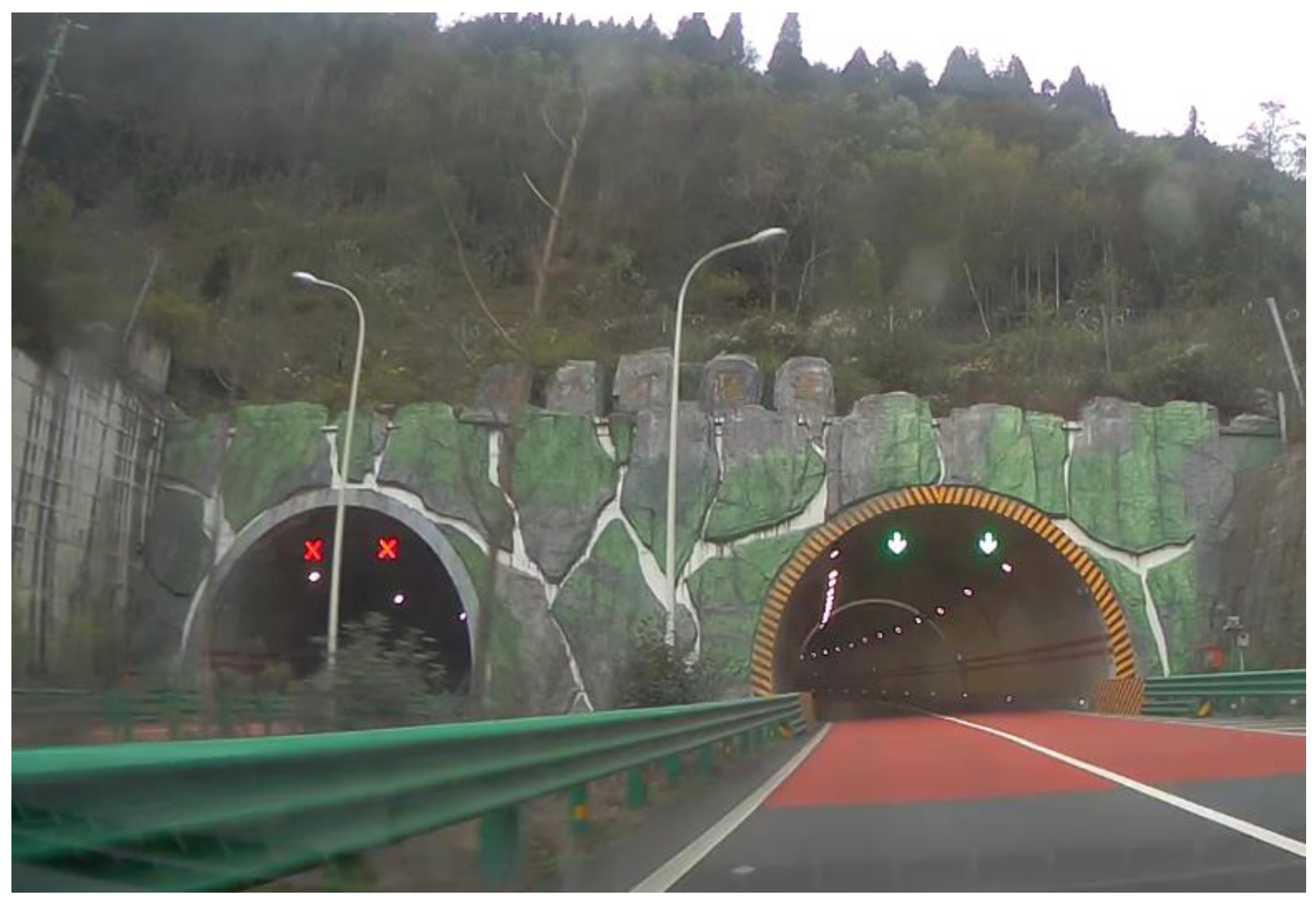
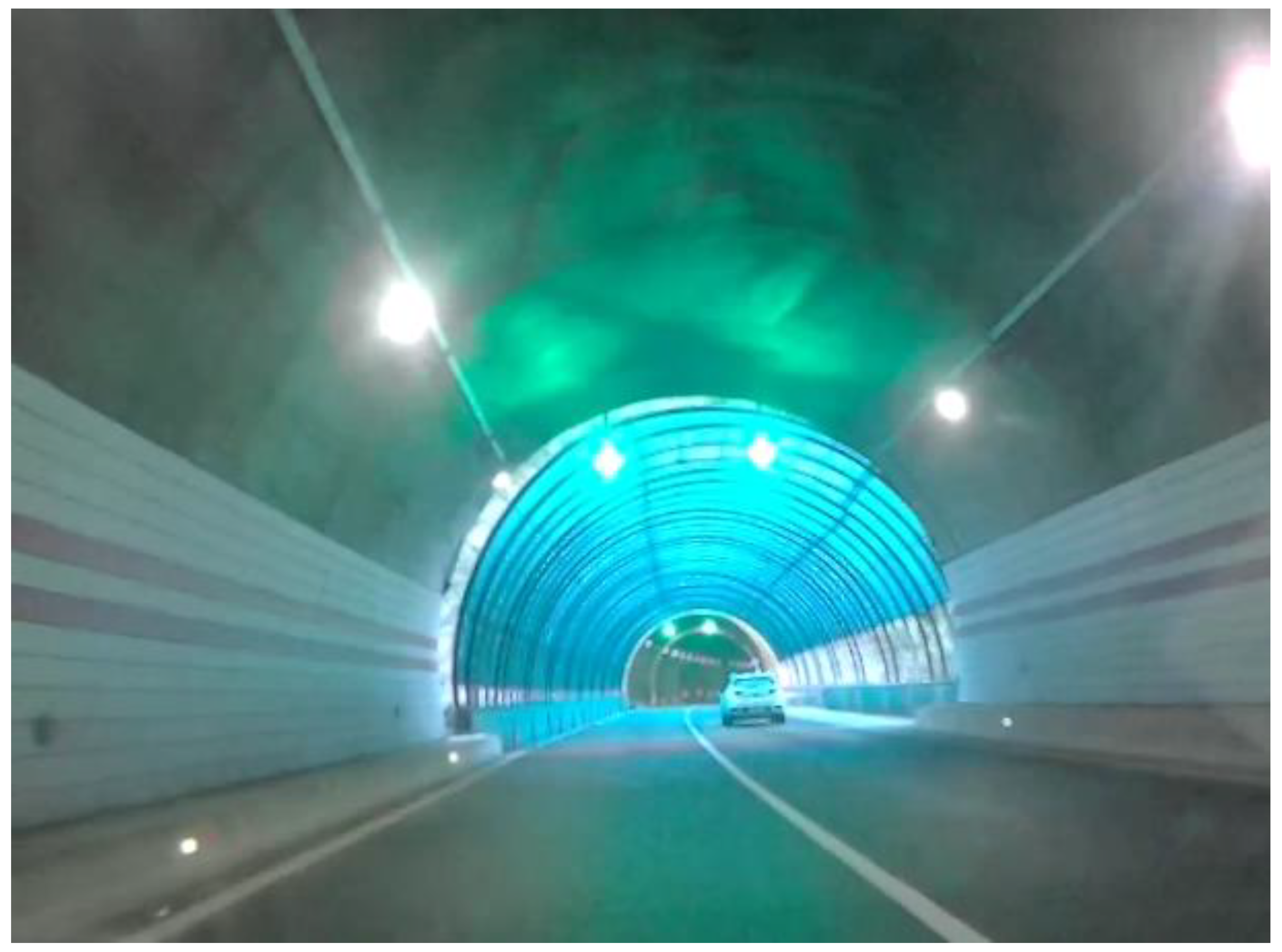
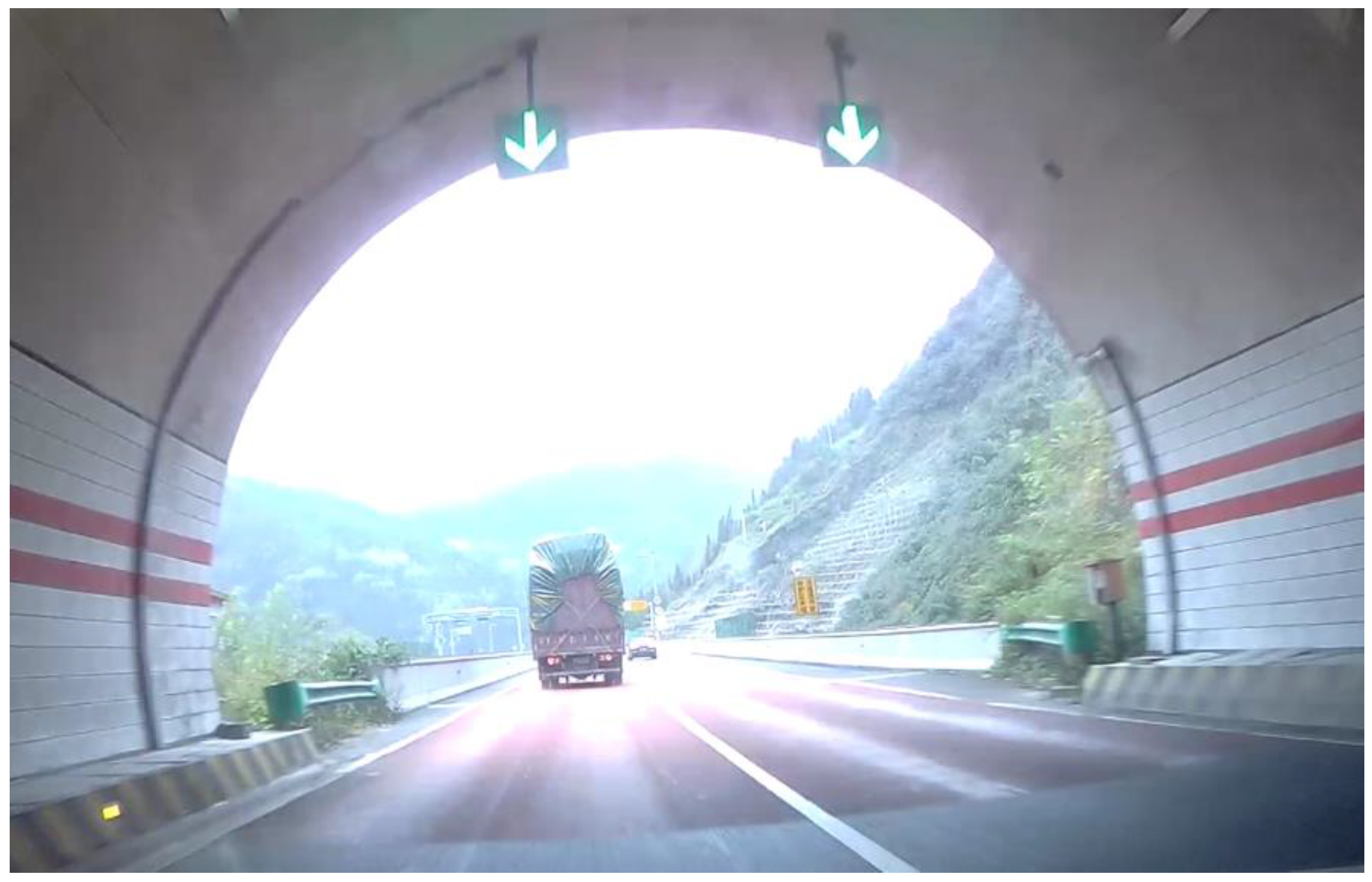
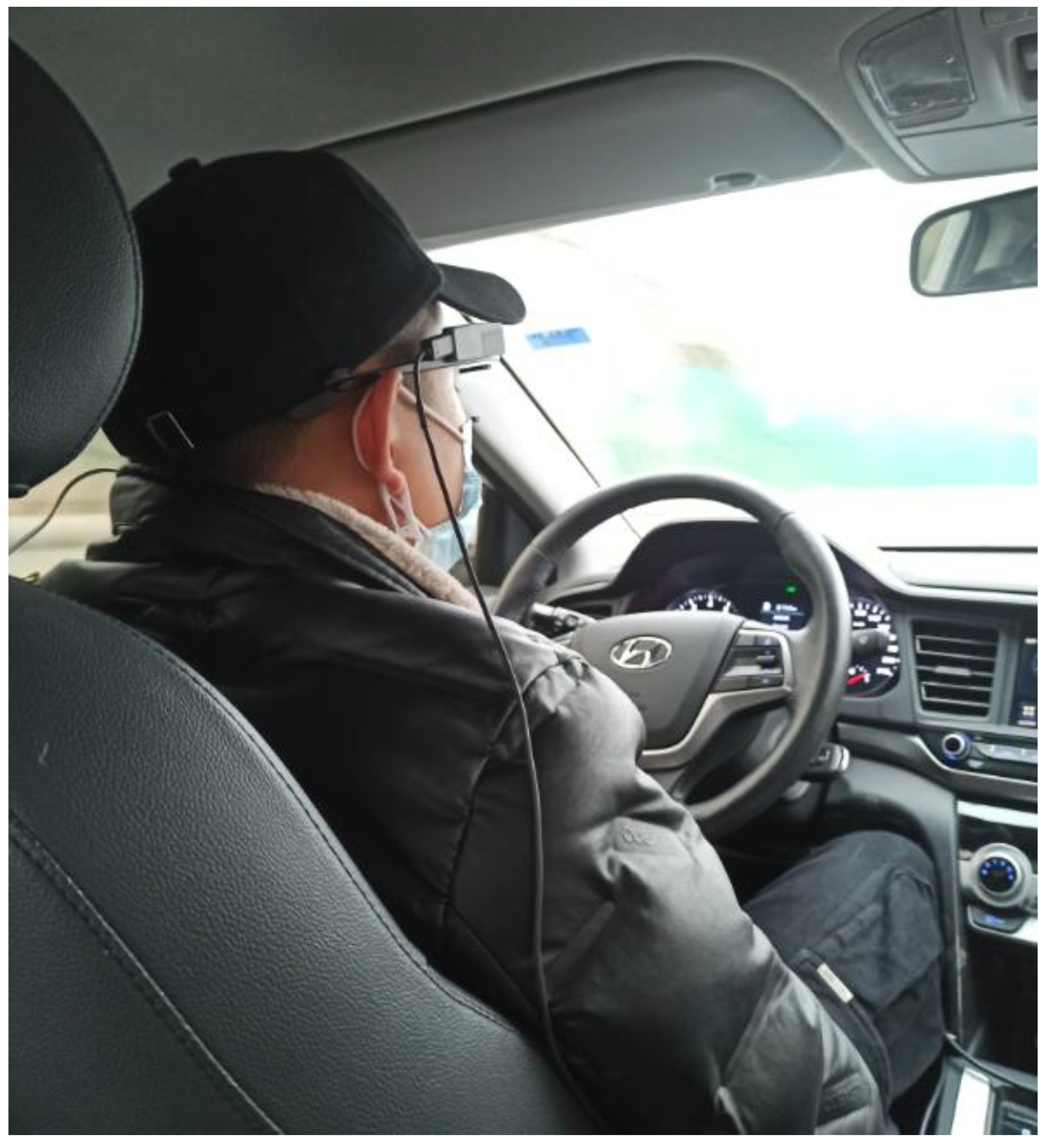
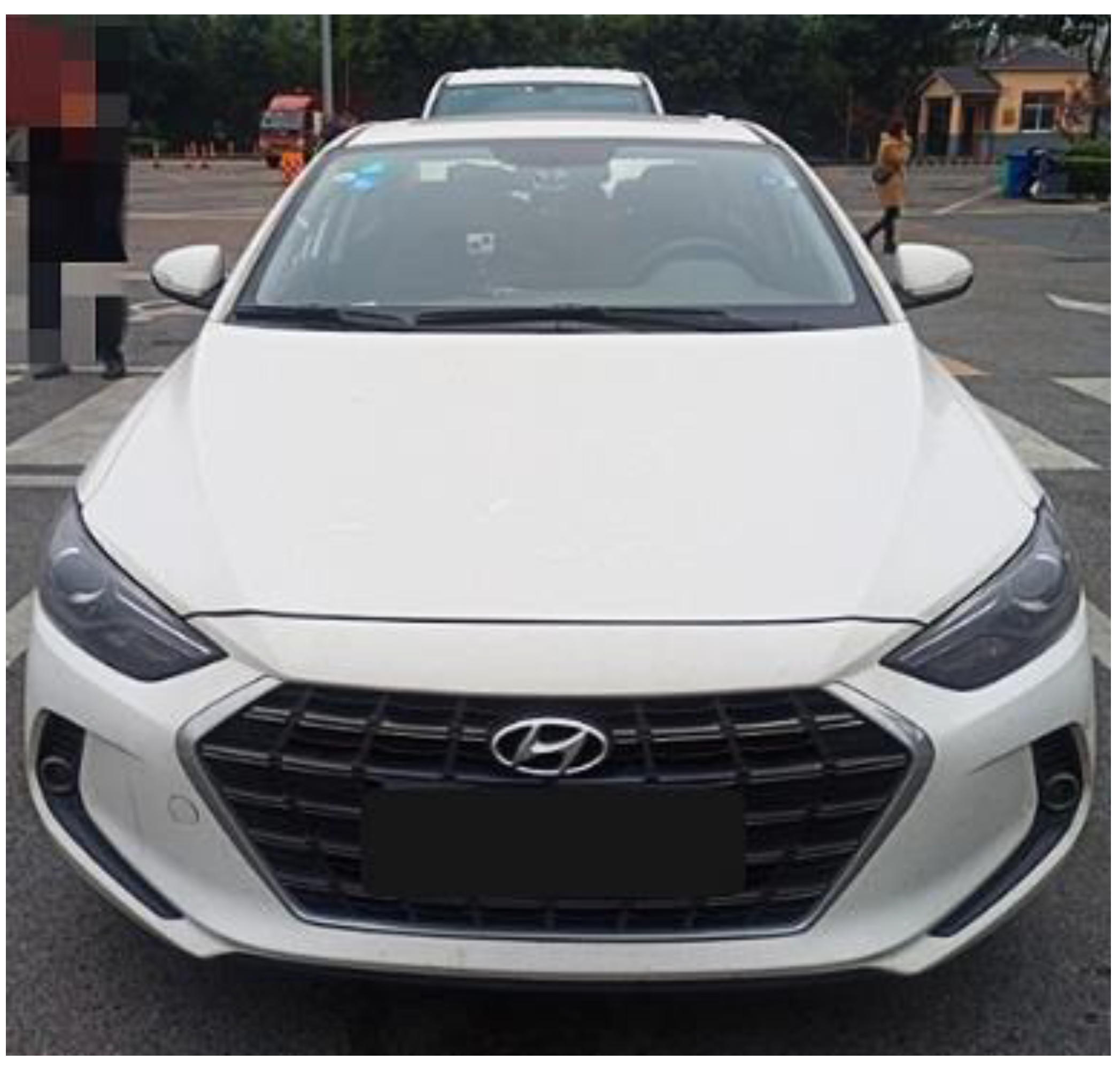

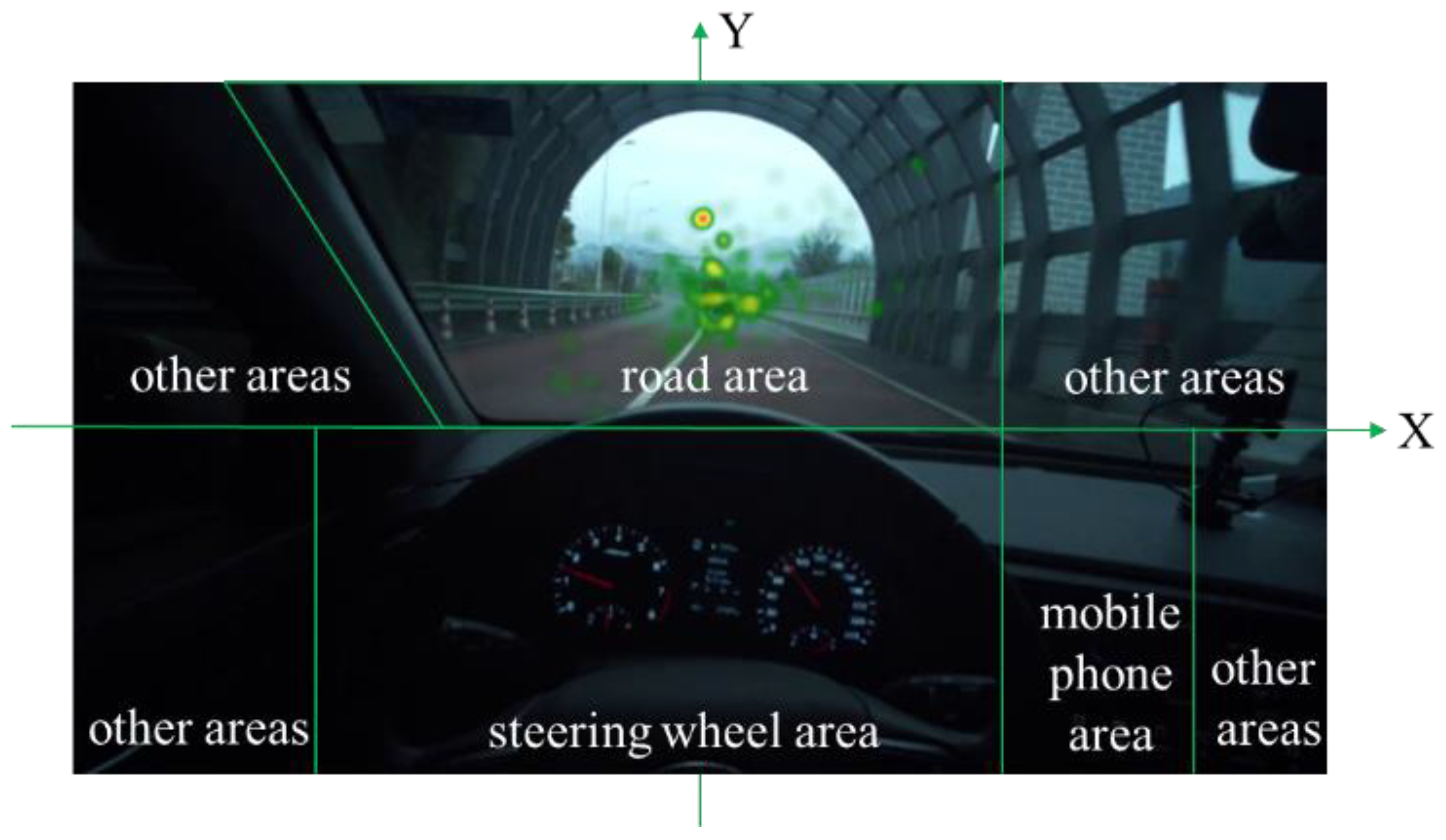
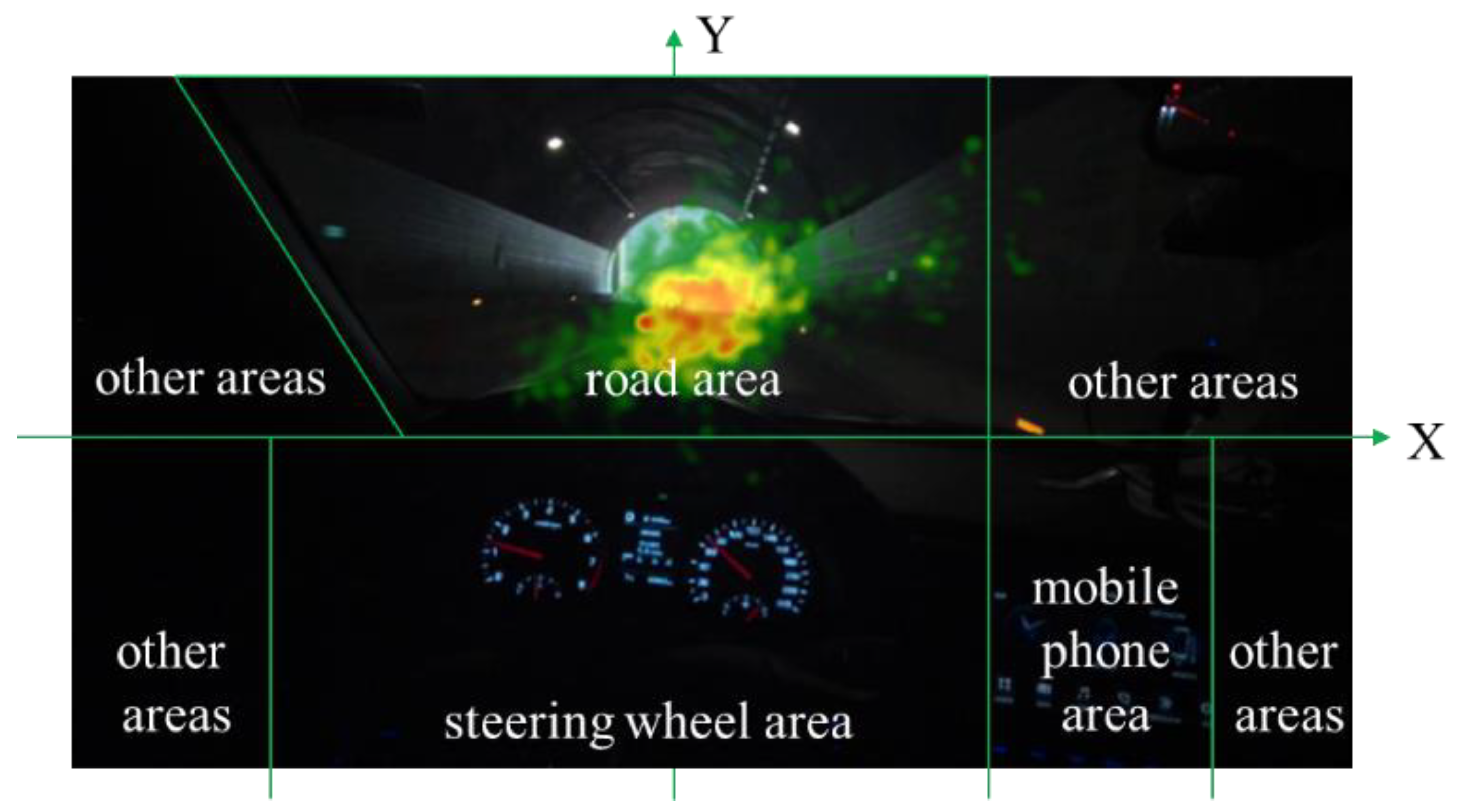
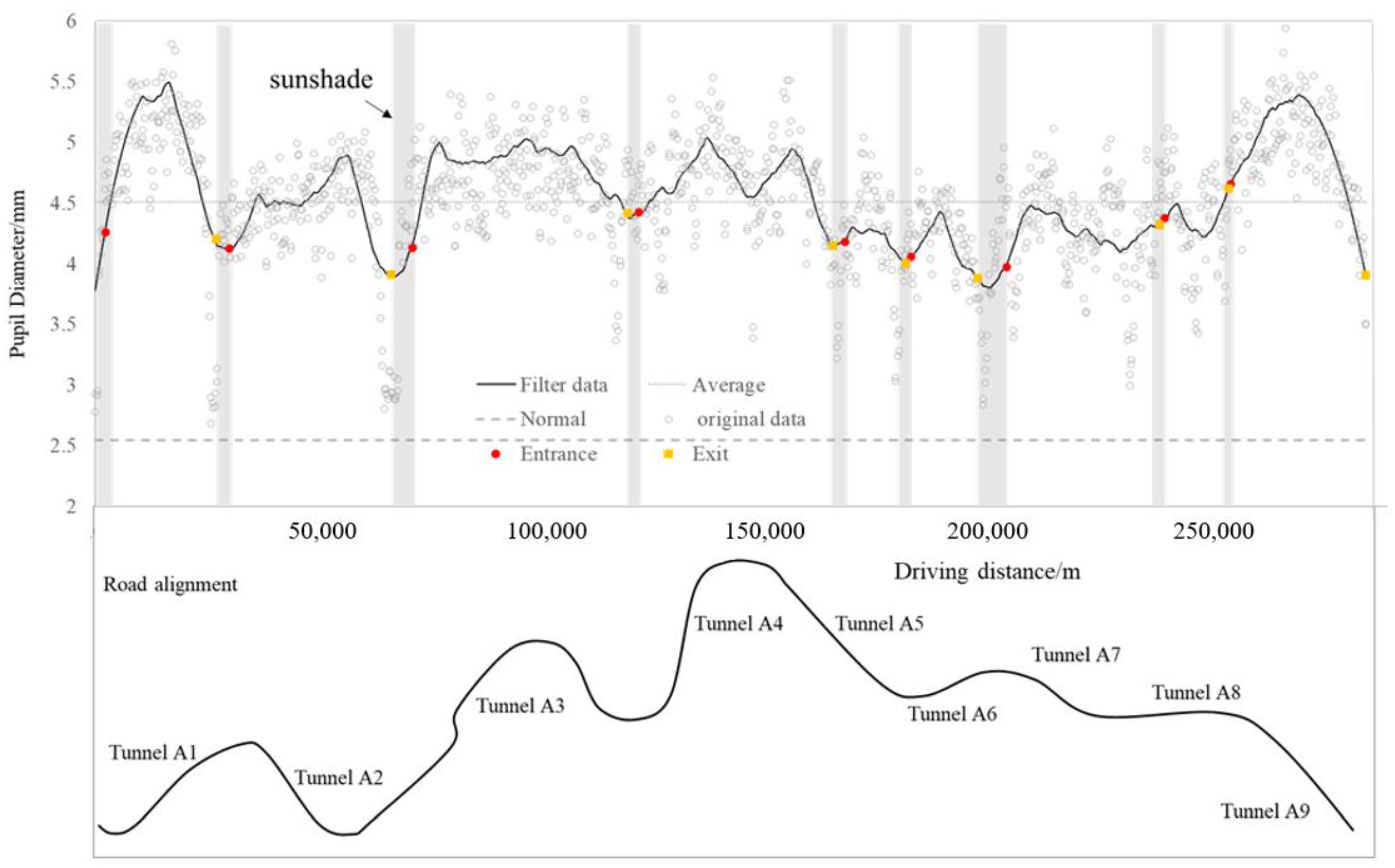
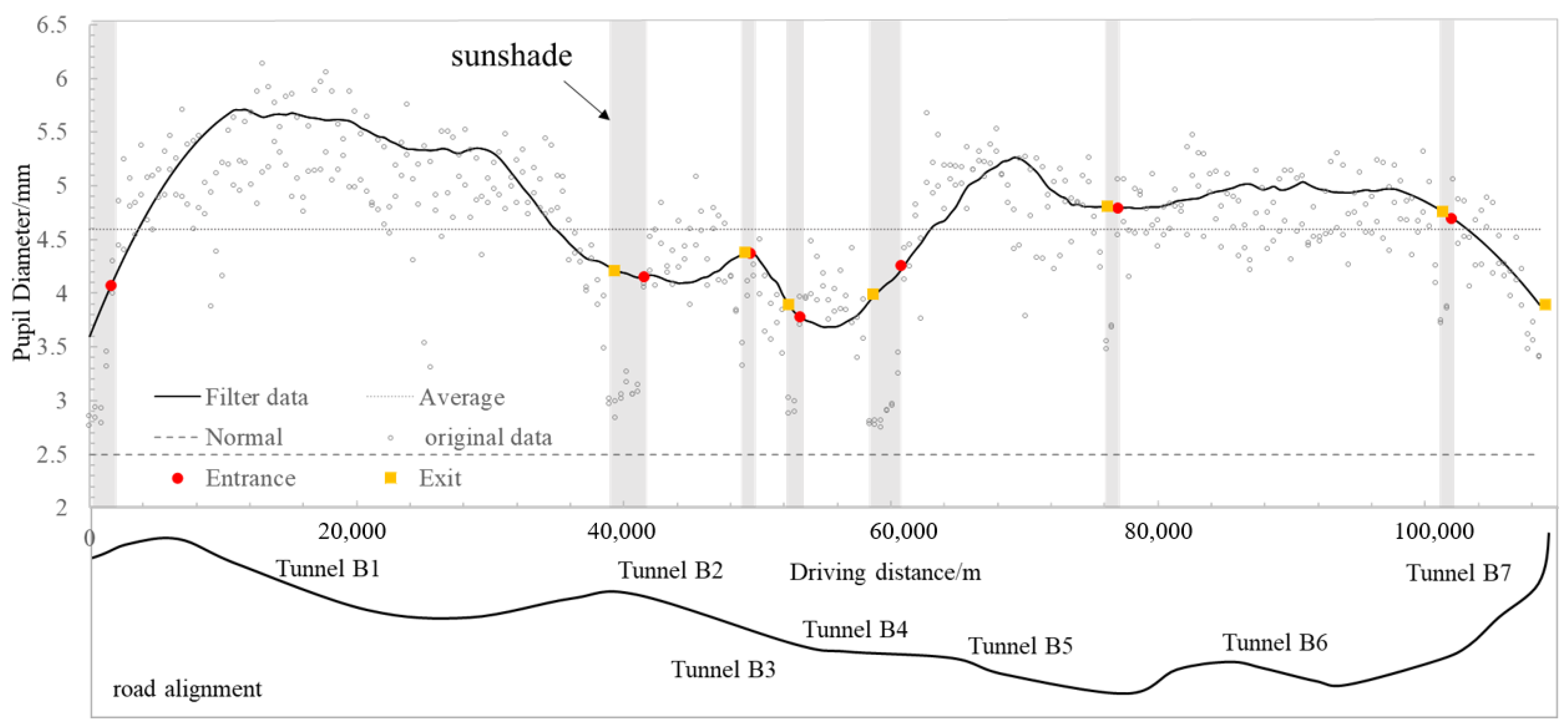

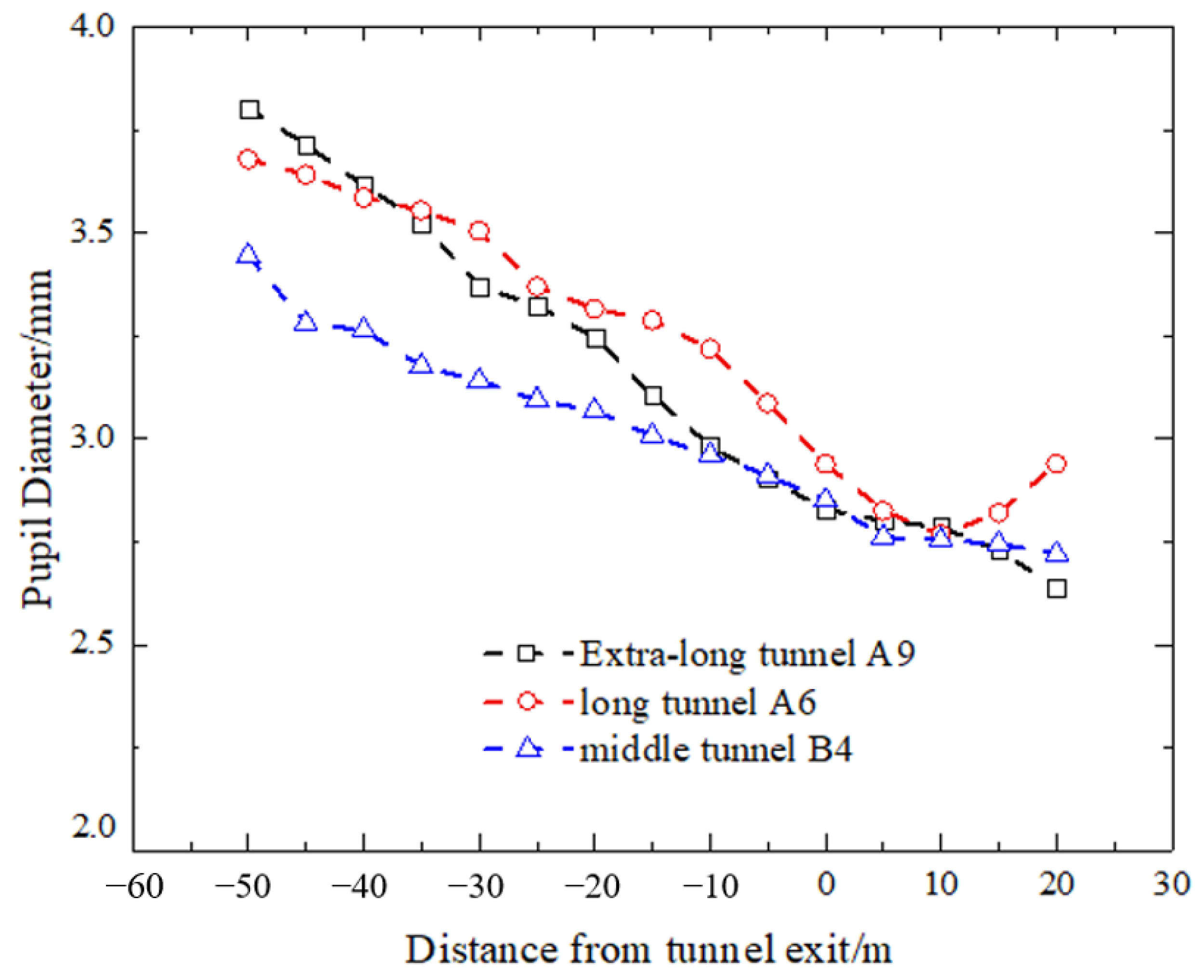

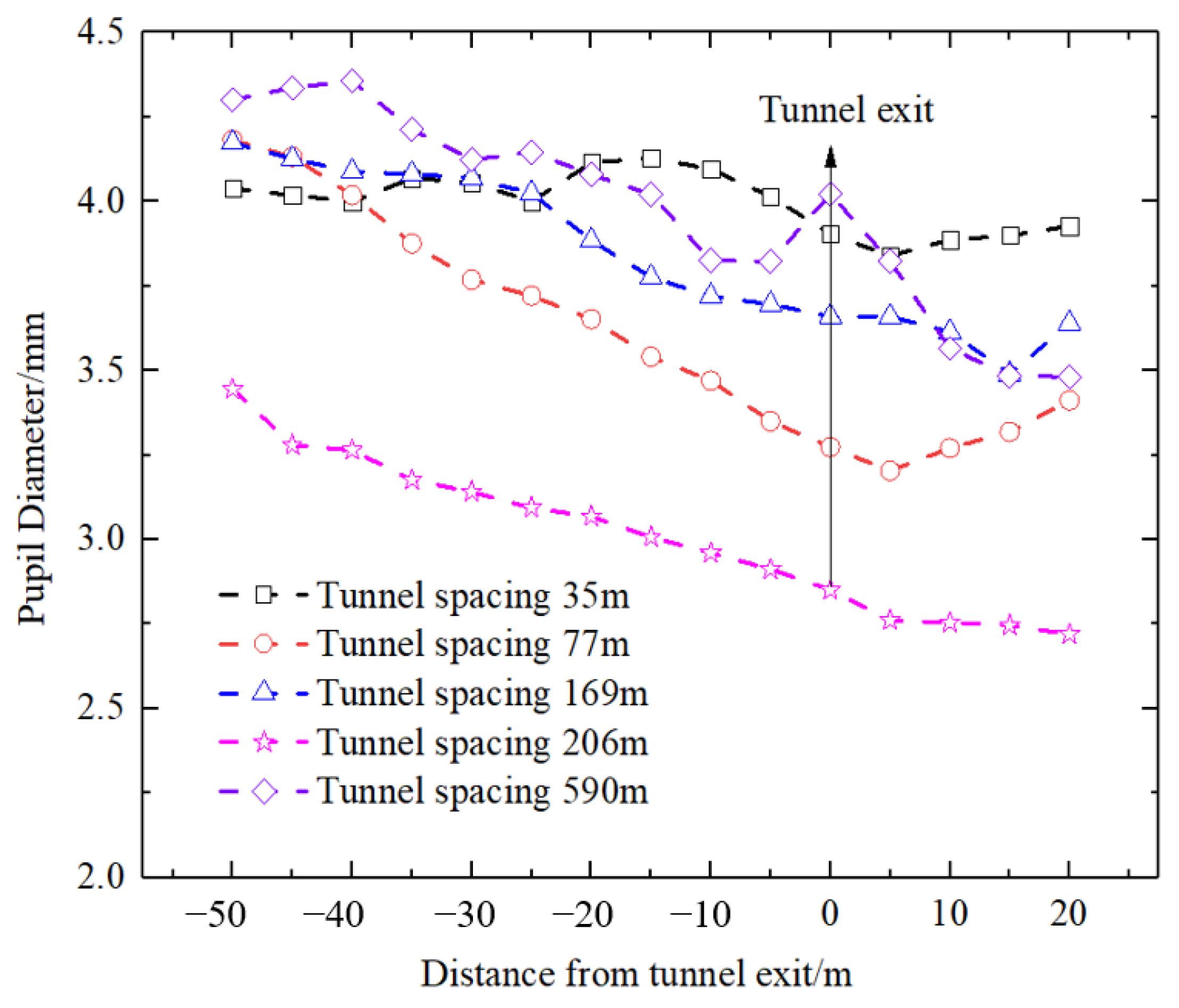

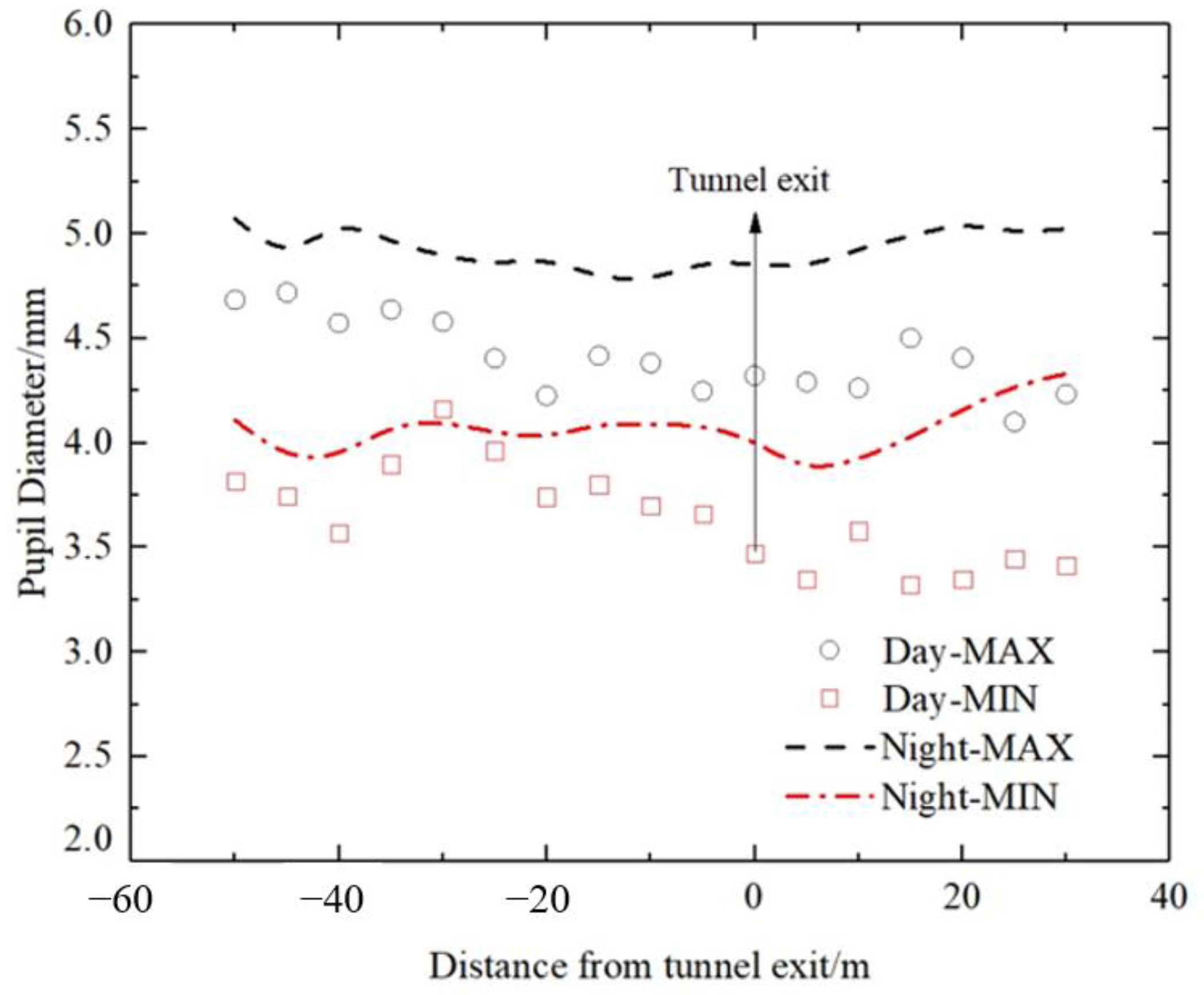

| Directions | Section A | Length (m) | Distance (m) | Longitudinal Slope (%) | Curve Radii(m) | Section B | Length (m) | Distance (m) | Longitudinal Slope (%) | Curve Radii(m) |
|---|---|---|---|---|---|---|---|---|---|---|
| Left | A1 | 2567 | 109 | 2.4 | 800~∞ | B1 | 3915 | 92 | 2.80 | 710~∞ |
| right | 2550 | 135 | 3796 | 202 | ||||||
| Left | A2 | 3769 | 280 | 2.4~2.94 | 710~∞ | B2 | 898 | 35 | 0.74~2.80 | 2124~∞ |
| right | 3740 | 265 | 820 | 44 | ||||||
| Left | A3 | 4847 | 68 | 2.59~2.80 | 800~∞ | B3 | 337 | 206 | 0.74 | 2500~∞ |
| right | 4858 | 82 | 336 | 79 | ||||||
| Left | A4 | 4730 | 590 | 2.30~2.59 | 834~∞ | B4 | 566 | 206 | 0.68 | 2500~∞ |
| right | 4712.6 | 587 | 562 | 194 | ||||||
| Left | A5 | 1300 | 77 | 2.30~2.93 | ∞ | B5 | 1708 | 51 | 1.80~2.70 | 1400~∞ |
| right | 1275 | 99 | 1661 | 74 | ||||||
| Left | A6 | 1953 | 66 | 2.20~2.80 | 1130~∞ | B6 | 1266 | 169 | 1.80~2.82 | 980~∞ |
| right | 1886 | 110 | 1277 | 199 | ||||||
| Left | A7 | 3123 | 99 | 2.30~2.80 | 1130~1250 | B7 | 621 | - | 0.50~2.80 | 710~∞ |
| right | 3126 | 125 | 614 | - | ||||||
| Left | A8 | 1508 | 45 | 2.22~2.80 | 1400~∞ | |||||
| right | 1481 | 62 | ||||||||
| Left | A9 | 3685 | - | 2.22~2.75 | 1500~∞ | |||||
| right | 3676 | - |
| /(mm2/s) | The Driver Visual Load Evaluation Results | |||
|---|---|---|---|---|
| Entrance | Exit | Evaluation Grade | Description | |
| <20 | <30 | <0.1 | A | comfort |
| [20, 30) | [30, 40) | [0.1, 0.2) | B | Slight discomfort |
| [30, 70) | [40, 85) | [0.2, 1) | C | discomfort |
| [70, 105) | [85, 105) | [1, 1.5) | D | Very uncomfortable |
| ≥105 | ≥105 | ≥1.5 | E | terrible |
| Number | /(mm2/s)/Evaluation Grade of Visual Load | ||||||
|---|---|---|---|---|---|---|---|
| Entrance Access Zone | Entrance Section | Entrance Change-Over Portion | Basic Segment | Exit Change-Over Portion | Exit Section | Exit Access Zone | |
| A1 | 4.11/A | 11.1/A | 17.78/A | 45.34/C | 11.83/A | 5.8/A | 3.81/A |
| A2 | 5.2/A | 6.51/A | 25.89/B | 24.36/B | 7.39/A | 2.93/A | 6.02/A |
| A3 | 3.31/A | 5.38/A | 11.27/A | 14.29/A | 7/A | 5.26/A | 3.13/A |
| A4 | - | 23.83/B | 16.04/A | 24.59/B | 11.06/A | 21.07/A | 4.49/A |
| A5 | - | 8.08/A | 8.66/A | 47.44/C | 42/C | 20.83/A | 6.44/A |
| A6 | 57.77/C | 6.01/A | 37.88/C | 13.02/A | 8.57/A | 4.9/A | 8.48/A |
| A7 | 6.19/A | 7.84/A | 8.07/A | 34.51/C | 51.81/C | 10.97/A | 15.1/A |
| A8 | 8.48/A | 21.42/B | 51.35/C | 40.51/C | 36.23/B | 31.7/B | 3.94/A |
| A9 | - | 42.4/C | 67.62/C | 50.44/C | 20.28/B | 3.69/A | 4.68/A |
| B1 | 35.1/C | 16.75/A | 19.91/A | 48.28/C | 23.17/A | 30.83/B | 10.95/A |
| B2 | 7.56/A | 7.88/A | 4.59/A | 47.85/C | 9.11/A | 23/A | 14.33/A |
| B3 | 3.97/A | 9.74/A | 11.31/A | 21.8/B | 5.39/A | 4.78/A | 10.07/A |
| B4 | - | 4.56/A | 4.05/A | 10.64/A | 9.6/A | 3.28/A | 3.55/A |
| B5 | 2.8/A | 14.59/A | 3.09/A | 5.79/A | 16.13/A | 3.33/A | 5.61/A |
| B6 | 7.96/A | 3.86/A | 5.3/A | 12.76/A | 9.08/A | 2.55/A | 32.66/B |
| B7 | 6.66/A | 5.23/A | 3.91/A | 16.89/A | 8.9/A | 30.96/B | 8.22/A |
Disclaimer/Publisher’s Note: The statements, opinions and data contained in all publications are solely those of the individual author(s) and contributor(s) and not of MDPI and/or the editor(s). MDPI and/or the editor(s) disclaim responsibility for any injury to people or property resulting from any ideas, methods, instructions or products referred to in the content. |
© 2023 by the authors. Licensee MDPI, Basel, Switzerland. This article is an open access article distributed under the terms and conditions of the Creative Commons Attribution (CC BY) license (https://creativecommons.org/licenses/by/4.0/).
Share and Cite
Zhang, B.; Bai, J.; Yin, Z.; Zhou, A.; Li, J. Study on the Driver Visual Workload of Bridge-Tunnel Groups on Mountainous Expressways. Appl. Sci. 2023, 13, 10186. https://doi.org/10.3390/app131810186
Zhang B, Bai J, Yin Z, Zhou A, Li J. Study on the Driver Visual Workload of Bridge-Tunnel Groups on Mountainous Expressways. Applied Sciences. 2023; 13(18):10186. https://doi.org/10.3390/app131810186
Chicago/Turabian StyleZhang, Bo, Jingrong Bai, Zhiwen Yin, Ao Zhou, and Jue Li. 2023. "Study on the Driver Visual Workload of Bridge-Tunnel Groups on Mountainous Expressways" Applied Sciences 13, no. 18: 10186. https://doi.org/10.3390/app131810186
APA StyleZhang, B., Bai, J., Yin, Z., Zhou, A., & Li, J. (2023). Study on the Driver Visual Workload of Bridge-Tunnel Groups on Mountainous Expressways. Applied Sciences, 13(18), 10186. https://doi.org/10.3390/app131810186






